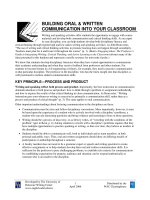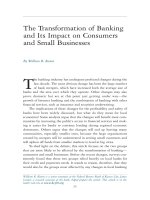ISSUE PAPER ON MARKETING AND EFFECTIVE COMMUNICATION doc
Bạn đang xem bản rút gọn của tài liệu. Xem và tải ngay bản đầy đủ của tài liệu tại đây (152.16 KB, 10 trang )
1
In a globalised economy, average consumption levels are on the rise due to:
• increasing world population;
• the expansion of middle and lower-income consumers and of a general culture of
consumption
• economic systems in industrialised societies based on consumption and production.
These current consumption patterns are unsustainable, and the improvements in energy
efficiency and the emergence of new technologies do not always outweigh them (called the
“rebound effect
1
”) resulting in increased environmental damage. We therefore need to direct our
consumption towards more environmentally friendlier products and services. Changes in our
lifestyles are necessary. For consumers this entails modifying the ways in which they choose,
use and dispose of products and services.
In this context, retailers, producers and other actors must help society reach its aims and
encourage more sustainable consumption patterns. Communication from different stakeholders
and public authorities to consumers should enable society to meet its environmental and climate
targets.
Marketing is the process associated with promoting the sale of goods or services. It is an
integrated process through which companies create value for customers and build strong
customer relationships. In return value from customers is captured.
Marketing is used to create customer demand, satisfy customer requirements and retain their
loyalty. Customer-focused marketing is based on the four Ps: product, promotion, price and
placement. Product communication to the consumer is mainly part of the promotion instrument.
The effectiveness of marketing instruments is usually measured in increased sales.
Improvements in customer satisfaction or customer loyalty are objectives of marketing
instruments even if it is hard to measure direct impact.
Marketing can have a role in leveraging the company’s sustainability credentials to build brand
equity. In order to do this, it is vital to ensure consistency with the respective corporate
sustainability strategy; any claims made must be consumer relevant, science-based and
presented in a specific, accurate and unambiguous manner.
Alongside consumer information and education in general, corporate reputation and product
marketing has a role to play in changing consumer consumption patterns. It enables consumers
to identify, choose and use environmentally friendlier products and services, by providing
information, relaying official campaigns and messages, ensuring availability and affordability.
1
The extent of resource savings created by efficiency gains, such as new technologies, that is taken
back by consumers due to an increased use of services and higher consumption.
2
Moreover, within the context of sustainable consumption and production (SCP), marketing and
communication can help address the issue of the “rebound effect” and to make consumption
patterns more sustainable. For instance, they can be used to communicate more sustainable
lifestyle messages.
Indeed, a recent Eurobarometer survey on European’s attitudes towards the issue of SCPi,
showed that more than 8 in 10 EU citizens felt that a product’s impact on the environment is
important when taking a purchase decision. This survey shows that a very large part of the
population is interested in buying more environmentally friendlier products. It also shows that
retailers have a unique opportunity to reach a number of people on a daily basis. Former
Eurobarometer studiesii however showed the wide gap between awareness and behaviour of
consumers.
The subject of marketing and effective communication is very broad and complex. Marketing, in
general, may be viewed in terms of the three pillars of sustainability i.e. the economic, social and
environmental. However, given the purpose of the Retail Forum, this issue paper will focus on the
influence that communication and marketing on the environmental aspects of sustainability can
exert on the final “average consumer”iii2 – not the niche “green” consumer.
There is currently no consensus, based on sound scientific, measurable and transparent criteria,
of what is meant by “sustainable” “green”, “ecological”, “environmentally friendly”,
“environmentally friendlier” etc. products. Given that all products have negative impacts on the
environment, we have used the term “environmentally friendlier products”. Within this term, we
propose to include all products which go beyond minimum legal requirements from an
environmental perspective. It therefore includes products such as eco-labelled products and
other certified schemes or industry-wideiv schemes and initiatives not subject to third party
verification.
For the marketing of environmentally friendlier products and services, companies use marketing
instruments which are well established for other products. The key challenge is to build trust that
such products and services produce measurable advantages for the environment and perform
equally well as the product formerly used, in a cost-effective way.
A number of company performance actions may influence the consumer’s decision to purchase
goods or services. All these actions of the company represent the “marketing mix”. These
instruments can be used either by brand owners or retailers for their private label products.
Marketing always constitutes an offer to consumers. In the competitive world between different
brands, manufacturer brands and retailer own brands and between numerous retailers,
consumers decide on the success of different marketing instruments through their daily
purchasing decisions.
For fast moving consumer goods (FMCG)v, “average European consumers spend 40 minutes
per major shopping trip, make 1.2 major trips per week and spend approximately 5 hours a
month in a supermarketvi. The most important determinants in the consumer’s decision to
purchase or not to purchase a particular product are the price and performance/quality of
products.
Consumers’ purchasing choices are also influenced by their faith in the brand. Companies can
also increase consumer trust and encourage enthusiasm for environmentally friendlier choices
through clear communication on what it means for their company to be “green”. This, alongside
3
the different promotion techniques outlined above, would provide consumers with something
positive to buy into.
Product:
The product aspects of marketing deal with the specifications of the actual goods or services –
the most important being the product performance, and how these relate to the end-user's needs
and wants. The scope of a product generally includes supporting elements such as warranties,
guarantees, and support.
Consumer research, product innovation and their development by producers and the listing of
these innovative products by retailers are core elements. For durable products such as white
goods (washing machine, refrigerators ) after sale services (repair, spare parts, etc.) are also of
key relevance to consumers.
Promotion:
Promotion includes advertising and sales promotion as well as promotional education and
personal selling. Purchasing decisions are motivated by emotional factors like trust and good
experience with a specific product or brand in the past. For some consumers, scientifically
reliable, consistent, understandable and non-misleading product information, shapes purchasing
decisions.
The goal of promotion is to make consumers aware of a product and its characteristics.
Consumers get product information through brand names, packaging information, like product
labels or additional information on flyers, websites, etc. The producer (brand or retailer brand) is
responsible for this information.
There is a basket of in-store-information retailers can use to promote green buying. A core
element is the dialogue with the sales person. In addition, there is signage, POS (point of sale)
display systems, etc. Also important is the opportunity to try new products (especially food
products) in the store.
Branded goods companies or retailers may inform consumers through newsletters or advertising
on TV or in newspapers. Some retailers (especially consumer co-operatives) use their member
sessions to inform the public about green consumption. The promotion of environmentally
friendlier products could be assisted through customer loyalty programmes.
Consumer awareness may also be enhanced through national or local public campaigns. With a
lot of media response and public awareness raising of some issues, the number of obstacles to
‘buying green’ can be reduced. The challenge for brand owners and retailers is to ensure that
environmentally friendlier products bring continuous satisfaction to consumers including the
delivery of expected performance, so as to make them do a reiterated 'green' choice.
Price:
The price, including discounts, of a product is generally – alongside performance – the main
criteria for purchasing decisions. This applies particularly for FMCG. In the case of consumer
durables, such as electrical appliances consumers are sometimes willing to pay more if they see
a good price/benefit correlation over the lifetime of a product/service.
Key to promoting green buying is the affordability of environmentally friendlier products. Even if a
majority of consumers claim in polls that they are willing to pay more for environmentally friendlier
products, the higher price is an obstacle for buying green. Even for green consumers there is a
limit to what they are willing to pay.
To promote green buying clear information to consumers about the costs involved during the life-
time of products is also key. In this sense, retailers can contribute to overcome the burden of
price with good communication. For instance, information about the lower electricity costs of
energy efficient white goods over the life-time of a product.
4
Placement:
The placement refers to the channel by which a product or service is sold (e.g. online vs. retail),
in which geographic region, to which consumer segment (young adults, families, business
people), etc.
The awareness and willingness of consumers to buy green differs from country to country.
According to the reportvii on organic farming in Europe, the most mature and developed organic
markets are in Austria, Denmark, Germany, the Netherlands and Sweden. Countries with a very
low share of the total organic food market are Spain, Greece, Portugal, Hungary and the Czech
Republic.
Concerning the product placement on the shelves, there are two general trends: off-shelf display
(green corners) or category groups (e.g. organic pasta next to whole pasta). For green conscious
consumers, green corners might be the better option as they are actively looking for green
products. For the average consumer, category groups might be preferable, as they are looking
for pasta and may, if presented with the option, decide to buy the organic alternative.
In periods of economic crisis such as today, these instruments, more specifically the price, take
on even more importance as competition between retailers increases. New competition elements
can also emerge. For instance, environmentally-based competition has penetrated the white
goods market (energy label). This might also prove to be the case for environmental
characteristics of products.
Assessing the effectiveness of marketing and consumer information
Methods for assessing the effectiveness of marketing and communication tools differ depending
on the actor (producer, retailer, environmental or consumer NGO etc.) and the initiative. For
retailers and producers the success of a marketing initiative will usually be assessed on the basis
of increased sales, numbers of people visiting the store etc. Sales data and market research
allow for a better understanding of consumer attitudes, beliefs and behaviours that can then be
fed into the planning process, driving innovation and guiding key business decisions, including
pricing, packaging and distribution.
According to the conclusions of the Green Claims research in the UKviii, consumers look for –
and respond to – three fundamental principles referred to as the ‘three C’s’ namely: clarity,
credibility and comparability. For consumers, effectiveness will be assessed on whether these
principles have been met.
Nevertheless, from a sustainability perspective the real challenge is to ensure that the consumer
will develop loyalty to environmentally friendlier products (purchasing these instead of other less
friendly ones) and changing their habits, when using and finally disposing of the product. For
instance, reverting to compact washing powder requires using less product per wash and that
washing at lower temperatures saves energy.
At European level, the renewed sustainable development strategy adopted by the European
Council in 2006, called for an action plan on SCP (Sustainable Consumption and Production).
The SCP and SIP (Sustainable Industrial Policy) Action Plan was adopted in July 2008ix. The
Action Plan is the EU’s contribution to a global (UNEP) process on sustainable consumption and
production, building upon both the Rio and the Johannesburg Summits. The Johannesburg Plan
of Implementation includes the following as measures to be taken as part of plans and
programmes on SCP:
• Develop production and consumption policies to improve the products and services
provided, while reducing environmental and health impacts, using where appropriate,
science-based approaches, such as life-cycle analysis
5
• Develop awareness-raising programmes on the importance of sustainable production
and consumption patterns, through education, public and consumer information,
advertising and other media
• Develop and adopt, where appropriate, on a voluntary basis, effective, transparent,
verifiable, non-misleading and non-discriminatory consumer information tools to
provide information relating to sustainable consumption and production, including
human health and safety aspects.
The EU’s action plan sets out measures aimed at improving the environmental performance of
products and fostering their uptake by consumers and public authorities. It contains other
concrete proposals:
On the production side
• extension of the Eco-design directive to cover all energy related products. Minimum
requirements are set for products with significant environmental impact, focusing on
key environmental aspects
• revision of the EMAS (Environmental Management and Audit System) Regulation
On the consumption side
• extension of the energy labelling directive to include more products;
• revision of the EU Ecolabel Regulation;
• the setting up of the Retail Forum;
• targets and guidance for green public procurement.
There is no specific EU legislation regulating environmental communication and marketing.
There is however a general directive on unfair commercial practices, which covers misleading
commercial practices and applies therefore to misleading environmental claims (see Art. 6 of
Directive 2005/29/EC). This Directive ensures that consumers are not misled and that any claim
made by traders in the EU is clear, truthful, accurate and substantiated, thus enabling
consumers to make informed and meaningful choices. Furthermore, the Directive aims to
ensure, promote and protect fair competition in the area of commercial practices. In order to
develop a common understanding and a convergence of practices when implementing and
applying the Directive, the Commission has recently published a document ("Guidance on the
implementation/application of directive 2005/29/EC on unfair commercial practices"
x
) on the key
concepts and provisions of the Directive, perceived to be problematic. A chapter of this
document is devoted to misleading environmental claims.
xi
At national level, some member states (e.g. France, UK) are taking initiatives to better control
environmental claims and advertising.
3
A major challenge towards sustainable consumption patterns is to foster in consumers long-term
environmental values which they integrate into purchasing behaviour and decisions.
Responsibility for such “education” lies primarily in the hands of public authorities and other
players whom consumers trust. For such education to be effective, however, identical or similar
messages must be given by a number of different sources. Producers and retailers have a key
role to play in conveying such messages: the producers as they are at the source of product
innovation and the retailers due to their strategic position in the supply chain together with their
long experience in working with players along the supply chain and alongside others, such as
NGOs, media, public authorities etc.
These messages have maximum effect if they are clear, simple and, when possible, highlight the
financial advantage for the consumer.
Consumers are increasingly aware of environmental issues - in particular, climate change - and
are more and more receptive to environmental messages. For instance, according to the
Eurobarometer survey on Europeans’ attitudes towards SCP, the level of environmental
6
awareness of the impact of consumer products is high: some 55% say they fully know or know
the most significant impacts of the products they buy. Consequently, there is much to gain for
front-running producers and retailers in adapting to new challenges such as climate change.
By embarking on the path of the environmental aspects of sustainability, companies can attract
new customers, and enhance their reputation and image, leading to greater customer loyalty (an
overriding objective of marketing), especially that consumer perception of the quality of products
increasingly integrates environmental aspects.
Competition amongst economic operators is a driving force for changes to take place, especially
in periods of economic recession and due to increasing public interest in issues such
as climate
change. Focusing on the environmental aspects of sustainability can therefore also become a
competitive tool for retailers, in particular if there is a relative financial advantage for the
consumer.
To increase consumer confidence partnerships must be promoted further, for instance through
campaigns involving retailers, environmental or consumer NGOs, manufacturers, industry
associations and public authorities (environment ministries, environmental agencies) etc.
Partnerships with NGOs may take different forms. Most frequently, NGOs provide assistance in
the development of the sustainability strategy of the company, the communication of
environmental information and the identification of environmentally friendlier products.
Retailers might help consumers by developing their offer of environmentally friendlier products.
Where appropriate, scientifically sound criteria, that take the entire product life-cycle into account
and are developed with input from all stakeholders concerned, should be used as the means to
decide the relative and absolute environmental friendliness of products.
Many studies on consumer behaviour demonstrate the wide gap between what consumers say
and what they do. Understanding and overcoming this barrier should therefore be a priority, using
research that already existsxii. When asked, consumers often identify the following barriers to
environmentally friendly consumption habits:
• lack of understanding how they, as consumers, can make a difference;
• lack of practical and relevant information about what they can do;
• that purchasing environmentally friendlier products is financially onerous;
• doubts about the quality and level of performance of environmentally friendlier products
However, information alone, even when simple, accurate, well presented and action focused, will
be insufficient to produce the shift towards more sustainable consumption. Just because
consumers are provided with more information, or say that they are interested in finding out
more, it does not necessarily mean that action will follow.xiii
In addition to a lack of awareness and understanding, the gap between awareness and action
can also partly be explained with behavioural biases. People may not behave rationally when
making purchase decisions due to habits that have been developed based on advertising and
promotion campaigns or brand loyalties.xiv
These remarks partially stem from the absence of a definition of environmentally friendlier
products. Making better use of the scientific research already available (recognised LCA
approaches with sound criteria for each product category, etc.) could solve some of the
confusion. Developing and communicating user-friendly consumer information based on available
scientific criteria (in particular LCA) could allow consumers to make informed choices. In addition,
available scientific data could be used by manufacturers/retailers to support innovation towards
more sustainable products.
In the absence of definitions and clear rules of what can be called “environmentally friendlier”,
some products carry environmental claims which are insufficiently substantiated. These tend to
be picked up by the media and are therefore potentially damaging to a company’s credentials,
and to consumer confidence in general. Only 6 % of respondents to the EU barometer survey
7
claimed to fully trust producers’ claims. In some cases, official Type I ecolabels provide a strong
definition and a benchmarking reference.
For this reason, many retail companies, fearing attacks from NGOs, the media or legislators, are
reluctant to promote products which meet standards beyond legal minima but without reaching
the highest possible levels, such as the GlobalGap.
Well-designed LCA tools can identify what the key environmental impacts are and where along
the lifecycle of the product they occur, whether in production, use or disposal. Misconceptions
about areas of greatest environmental impact lead to the general conclusion that claims should
convey the overall picture. Yet to deliver an effective communication, it is important to convey the
whole picture.
Consumers also sometimes expect environmentally friendlier products to cost more than
standard products: they therefore tend to be niche markets. However, prices could be reduced by
means of public procurement, and fiscal incentives which would allow economies of scale. In this
framework, the EU is undertaking measures, such as the elimination of harmful subsidies or a
possible ecological reform etc.
Consumers also occasionally question the performance of environmentally friendlier products.
These issues become especially relevant in periods of economic uncertainty.
The competitive nature of company purchasing and the legal framework has prevented retailers
from sharing best practice on sustainability issues such as criteria selection for better performing
products. However, when possible relevant retailers could work together more than in the past, to
create a market-wide demand for environmentally friendlier products. DG Competition needs to
be part of the discussion, to avoid anti-trust arguments coming when these are not appropriate.
There is also a practical obstacle to the promotion of environmentally friendlier products, namely
that the supply does not always meet the demand, as is the case for organic products. In such
cases, producers and retailers might decide to source globally and the environmental credentials
of the products they sell might be put at risk.
Finally, the capacity (in terms of available resources) for retailers to support individual
manufacturers or industry sectors voluntary initiatives in stores is limited.
•
The legal dimension can also prove to be an obstacle. In particular, the amount of mandatory on-
pack information required may cause the key messages to be overlooked.
National implementation is not always in line with EU legislation, as in fishing quotas, preventing
clear, simple, homogeneous information as well as an agreement on what is sustainable.
Therefore, better enforcement of existing EU legislation is necessary.
Increasingly, antitrust rules may make businesses behave very cautiously when considering
collective voluntary action to raise product standards, for example if retailers are invited to
consider decisions on choice-editing of certain types of products.
•
In smaller companies, environmental challenges might not always be fully taken into account.
This lies mainly in the fact that environmental measures are often proportionately more
burdensome for smaller companies than for larger ones.
For larger companies on the other hand, there are also occasionally diverging views between the
marketing and sustainability departments as to what is a “sexy” product or message to put
forward. A specific case of the retail sector is that companies are often structured in such a way
as to leave as much discretion as possible to each shop regarding what they sell and the
messages they convey, limiting the possibilities for large scale marketing and communication.
8
According to a recent study on retailers and CSRxv, progress along change trajectories towards
effective CSR requires both internal and external strategic and operational alignment.
To communicate their general company sustainability strategy, large producers and retailers use
sustainability reports. Yet generally these are not directly addressed to consumers but to
shareholders etc. Communication on this point needs to be improved to help improve the
credibility of the retail brand.
Changing consumer habits and consumption patterns towards more sustainable ones is a long-
term objective.
• develop a common vision and policy on SCP
• stimulate discussions on SCP in the framework of the EU 2020 strategy and economic
recovery exit strategies
• building on already available references and benchmarks, develop sound definition and
common understanding of what are environmentally friendlier products and what the key
environmental hot spots are for each product category (building on already available science +
framework to elaborate guidelines);
• identify what messages should be conveyed, in order to support consumers making
informed choices and to promote behavioural change including after sales;
• closing the gap between what consumers say and what they do;
• make environmentally friendlier products with a good performance affordable;
• convincing consumers to buy an environmentally friendlier product repeatedly with a view to
a final change in consumer behaviour;
• reconciling product information and broader messages (sustainable life-style etc.), without
ignoring the fact that information overload negates the benefit of the information
Most of the following points can also apply to producers and other economic operators:
• facilitate access to environmentally friendlier products at affordable prices, in particular
through a widening of the range of environmentally friendlier products;
• all environmental claims should be clear, credible and comparable. Claims must rely on
verifiable, science-based, transparent information and easy-to-understand labels. Third-party
verification schemes can be an option;
• build on potential existing campaigns and relay such sustainable consumption messages
through participation in government and civil society campaigns (e.g. sustainable energy Europe
week, mobility week, world environment day…);
• mobilise their marketing and communication teams towards sustainable development : notably
by generalising dedicated training
• communicate the company’s vision on sustainability internally and externally and ensure that
the stores concerned meet the respective messages communicated and are consistent at all
stages;
• build into the development of marketing campaigns an assessment of the potential impacts
on consumer behaviour with regard to sustainable consumption. Ensure close cooperation
between the marketing, communication and environment departments;
• develop a clear vision of what it means for a company to be green;
• the preference of consumers may depend on a variety of different factors. Retailers and
producers should do research with their own customers to determine how they can maximise
easier green choices for consumers;
• raise-awareness and train store teams on environmental issues (waste sorting, plastic bags,
energy management, etc.) and their purchasing and sales staff about environmentally-friendlier
products.
9
• Ensure coherence between different policy areas
• when reviewing the SCP action plan, analyse the issue of consumer behaviour. Other issues
to consider are (i) the assessment of good practice models to encourage behavioural change and
(ii) build in state of play of what consumers want/understand
• improve the knowledge base, identifying the hot spots according to consistent and credible
LCAs. Current environmental LCA databases are often incomplete (missing emission factors for
many common ingredients and components). Harmonisation between these databases and LCA
methodologies is needed to make them interoperable and produce robust, reliable and
comparable results.
• intensify efforts for better consumer education and consumer trust by public authorities and
other players consumers trust. Messages must also be consistent over time.
• facilitate access to environmentally friendlier products at affordable prices, introduce
different types of incentives for consumers;
• revise mandatory rules for labelling in order to limit on-pack information to a minimum and
through this achieve greater clarity of information. Other instruments such as SMS or websites
might prove more appropriate for some information particulars;
• provide guidance on corporate green claims
• educate consumers on the environmental benefits of correct product use and correct
packaging disposal;
• stimulate and promote ecolabels, the organic and other certified schemes to increase the
number of products with such labels or information (e.g. information on websites). Enhance the
knowledge and credibility of these schemes and improve even further their credibility;
• promote green public procurement
• Collaborate further with all the relevant stakeholders along the supply chain, including public
authorities, to share best practices regarding the promotion of environmentally friendlier products
and to develop simple common messages on issues to be identified and/or build on existing
initiatives.
• conduct marketing and communication assessments to focus more on sustainability criteria,
including comparison between the effectiveness of different communication tools and their
deployment;
• consumer education: conduct campaigns linking consumption and lifestyle. For some
products the major environmental impacts are related to the way the products are used and dealt
with as waste; some types of products promote more sustainable lifestyles than others. Involve
all relevant parties in such campaigns to make a sustainable lifestyle trendy.
• build-on existing best practices, partnerships, campaigns and voluntary actions carried out
by relevant stakeholders to optimize their visibility, their reach out and thus their impact/influence.
• organise an event 2011 for all stakeholders so as to provide a platform for discussion on the
required steps for the review of the SCP Action Plan.
• undertake research with consumers to ensure understanding of consumer wants and needs
as well as the barriers they face to taking up environmentally friendlier products and services.
i
ii
Eurobarometer 295: Attitudes of European Citizens towards the environment, March 2008
.
v
vi
viii
10
ix
x
xi
xii
xiii
xiv
xv









